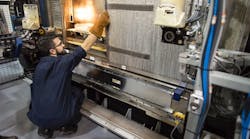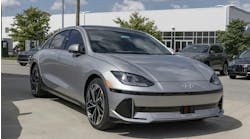Ford Takes the Long View with Large-Scale 3D Printing
One of the big practical challenges of printing larger 3-D printed parts is spatial. To get the dimensions precise, it’s best to perform the process in a temperature controlled chamber or oven. Conventional 3-D printing is done vertically, and according to Ford’s Ellen Lee, technical leader for the company’s additive manufacturing, “there is not a practical way to print very tall parts within that chamber/oven without having an extremely tall printer.”
Print laterally, though, and you can have an opening at the back of the printer that pushes out parts on a track in back of the chamber. By the time the parts exit the oven, “they are already quite dimensionally stable,” says Lee.
Since last fall, engineers at Ford have been testing a 3D printer that builds objects horizontally. The printer, called the Infinite Build, is developed by the Israeli additive manufacturing company Stratasys. For prototypes, it can produce objects that fit within the print volume of 30”x 48”x infinite. Boeing is also testing the technology.
The industrial-sized printer sets the usual configuration on its side—the platform is set North-South instead of East-West—and builds out instead of up.
VIDEO: See the 3D printer in action.
The material is also different than conventional 3D printing: Instead of a continuous filament, the printer uses thermoplastic micropellets, and the refilling process is automated, “so if we have very, very large parts, we have automatic material handling that allows continuous operation for days,” says Lee.
Lee says the technology “lends itself itself well to fixtures and tooling applications in the near term. In the future, “large parts that may require some mechanical performance for functional testing are where we see the value.”
But don’t look for mass production of parts on Infinite Build anytime soon. “Even though this printer is much faster [than most], it still can’t compete with those mass production processes like injection molding,” she says. “Typically, today we would injection mold a larger bumper in a minute or two. Here it would still take a couple of days, depending on the actual size and geometry.”
Ford, of course, isn’t the only automaker devoting considerable R&D to the latest in additive manufacturing: BMW recently committed venture capital to Desktop Metal, a 3D printer that melts layers of metallic powder with lasers. And Delphi (as well as Ford and BMW, in separate projects) has been working with the Carbon printer that pulls objects out of a pool of resin rather than building them up layer by layer. That printer lends itself well to smaller parts that require a nice surface finish or materials beyond your typical brittle prototyping resins.
Lee says Ford’s strategy is to partner with 3D printing innovators early in the technology’s development to modify it “specifically for our automotive needs. There are a lot of new and established 3D printing companies that we are in discussions and partnering with to understand what the potential for their technologies are,” she said.





